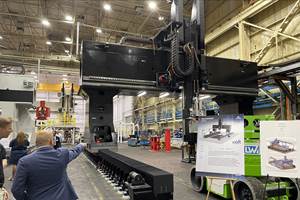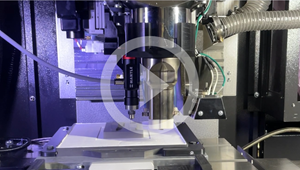AddUp Adds Constellium’s Aheadd CP1 Aluminum Alloy to Material Portfolio
The Aheadd CP1 aluminum alloy was developed by Constellium for the needs of additive manufacturing by laser powder bed fusion specifically for high-performance and lightweight applications.
Share
Read Next
AddUp has expanded its material portfolio by adding Constellium’s Aheadd CP1 aluminum alloy to its FormUp 350 machines, offering a high-performance alternative to traditional aluminum alloys for additive manufacturing (AM).
Constellium’s Aheadd CP1 alloy can now be used on AddUp FormUp 350 machines. This aluminum alloy is specially developed for the needs of AM and is said to provide an interesting alternative to traditional grades such as AS7 or AS10, with higher productivity and better performance for heat dissipation applications.
AddUp qualified the new aluminum alloy Aheadd CP1 for FormUp 350 machines. This alloy was developed by Constellium and was designed for the needs of AM by laser powder bed fusion (LPBF) specifically for high-performance and lightweight applications.
The current AM market is dominated by AS7 and AS10 grades (alloys of aluminum, silicon and magnesium, originally created for the foundry industry). Constellium offers an aluminum-iron-zirconium alloy with higher solderability which makes it possible to increase laser power and scan speed, and therefore to improve productivity. The gains can range depending on the type of part to be printed, and more could be achieved in the next years.
Above all, with Constellium alloy, post-build operations are simplified. “To obtain the best mechanical properties using AS7 and AS10 grades, several long and expensive post-build treatments must be carried out, such as hot isostatic pressing and, solution and aging, etc.,” says Frédéric Sar, Materials Officer at AddUp. “With Aheadd CP1, very similar material properties can be achieved with a simple heat treatment at 400°C.”
Saving time and money on these post-printing operations, which represent up to 40 to 50% of the cost of LPBF parts, can make a difference in the profitability of an application.
In detail, the mechanical properties of parts made by AddUp from Aheadd CP1 (particle size 20-63 micron) are close to those of AS7 in terms of hardness, at least equivalent in fatigue resistance and higher in ductility. These parts are also compatible with anodizing treatments to improve corrosion resistance.
Higher thermal conductivity of Aheadd CP1 compared to traditional aluminum alloys makes Constellium’s alloy a better candidate for heat exchanger applications. This alloy is stable up to 250°C without degrading its microstructure. Therefore, the parts made out of this material can be used at higher temperatures compared to AS7, which paves the way for lightweight applications for the aerospace industry.
All these characteristics make Aheadd CP1 a potential alternative to AS7 and AS10 alloys for 3D printing. This material was recently approved in the field of motorsports. Combining this material with performance of the AddUp FormUp 350 machine, increases the productivity without compromising the part quality. This material could quickly gain significant interest in many other industrial sectors, including aeronautics and aerospace.
- Read about AddUp’s participation in a $1.5 million USAF Research on IN-718 additive manufacturing. AddUp is partnering with Zeda to provide critical project support to provide the USAF with a set of manufacturing guidelines to maximize the capabilities of LPBF to meet fleet readiness and sustainment goals.
- Read about another Addup collaboration with Zeda — this time for aerospace and medical additive manufacturing. The first of eight AddUp FormUp 350 powder bed fusion machines deployed has been installed at Zeda to support its growth in the aerospace and medical sectors.
Related Content
Postprocessing Steps and Costs for Metal 3D Printing
When your metal part is done 3D printing, you just pull it out of the machine and start using it, right? Not exactly.
Read MoreWorld’s Largest Metal 3D Printer Seen at Ingersoll Grand Opening Event
Maker of large additive and subtractive machines adds capacity in Rockford, Illinois.
Read MoreHow to Build 10,000+ Shot Molds in Hours
Rapid tooling isn’t so rapid when it takes days to 3D print a metal mold, and then you still must machine it to reach the necessary tolerances. With Nexa3D’s polymer process you can print a mold in hours that is prototype or production ready and can last for more than 10,000 shots.
Read More3D Printing Molds With Metal Paste: The Mantle Process Explained (Video)
Metal paste is the starting point for a process using 3D printing, CNC shaping and sintering to deliver precise H13 or P20 steel tooling for plastics injection molding. Peter Zelinski talks through the steps of the process in this video filmed with Mantle equipment.
Read MoreRead Next
At General Atomics, Do Unmanned Aerial Systems Reveal the Future of Aircraft Manufacturing?
The maker of the Predator and SkyGuardian remote aircraft can implement additive manufacturing more rapidly and widely than the makers of other types of planes. The role of 3D printing in current and future UAS components hints at how far AM can go to save cost and time in aircraft production and design.
Read More4 Ways the Education and Training Challenge Is Different for Additive Manufacturing
The advance of additive manufacturing means we need more professionals educated in AM technology.
Read MoreHybrid Additive Manufacturing Machine Tools Continue to Make Gains (Includes Video)
The hybrid machine tool is an idea that continues to advance. Two important developments of recent years expand the possibilities for this platform.
Read More






















